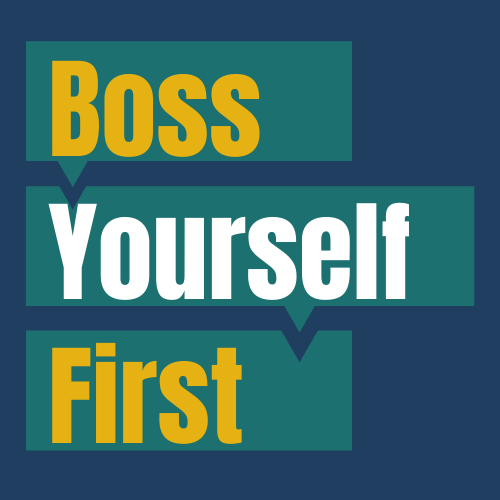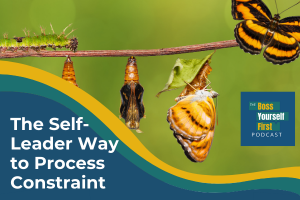The Self-Leader Way to Process Constraint
In this episode, we are jumping into the process of leveraging constraint. We explore each stage and I share a bit of my journey with constraint. Where are you in the process? Once you find out, you can take specific steps to move forward to get where you want to go with new perspectives and new energy.
Episode Transcript
Hello! I hope you’re having a fantastic week. What is your “normal” right now? Have you settled into a pandemic rhythm? We have for the most part. My youngest was in school with a hybrid model and then it switched to all on line and now she goes back to the hybrid model again next week. The other three of us in the house are working at home full time. my youngest is just finishing up college applications. Then it’s just waiting to see where she will wind up next fall. And IB tests to wrap up her senior year. My husband’s busy season is wrapping up while mine is winding up but that’s okay. He’s pretty great and We shift the household responsibilities around according to our work schedules. My youngest grandson is teething, so my oldest daughter has her hands full.But You know, life is chugging along. Sometimes that’s just perfect, we can rest a bit, restock our energy reserves. But sometimes when that regular rhythm of life has been steady for a while, we get comfortable and we lose energy on our goals., we need a little something to wake us up, engage us and help us move towards our objectives. That is part of self-leadership recognizing when to reenergize and when to get up and get going on those goals. I think this is a great time .to talk about this as we’re fully into the first quarter of the year, whether you set resolutions or if you’re like me, I set out yearly vision and break that into quarterly check points, we start strong but as we get into the rhythms of the new year, we lose motivation and interest. Well, this season we’re talking about something that can help. That something is constraint. Yes, you heard me, constraint can help wake you up and when you connect it to strong motivation – you can slingshot forward toward your goals with new perspective, creative thinking and bold actions. Now I’m getting a little ahead of myself because we’re only on the second episode of the season, but I want you to grab hold of the rewards of doing this work with constraints. On episode 1 we talked about how we’re defining constraint and looked at examples of how constraint can be leveraged. We even started playing with constraint with our very own constraint challenge. So this week, i want to focus in on the cycle of processing constraint. We talked about it last week but as a reminder, our book for this season is A Beautiful Constraint by Mark Barden and Adam Morgan and if you want the BYF reading schedule you can visit the Boss Yourself First Facebook page and we’ll be talking about our reading inside the Boss Yourself Facebook Group which is completely free to join and we’d love to have you. So remember last week we combined a couple of definition including one from our A Beautiful constraint to define constraint as a limitation or defining parameter imposed by outside circumstances or by ourselves that can stimulate creativity and innovation. I want to talk to you about the cycle of processing constraint and I want each of us today to figure out where we are in the process of dealing with a constraint. In Morgan and Barden’s book they identify three stages of processing constraint. I love this because it removes the idea that we do this work, and we will automatically feel great about working with constraint. The stages of processing constraint are victim, neutralizer and transformer and they break that down into actually two kinds of transformers that we’ll get into in a minute. It kind of reminds me of the stages of grief but as I thought it over it’s a little more like using a sling shot. Stage one the rock is placed in the sling and the sling is pulled back tighter and tighter creating tension and then you have Stage two that time while you’re aiming that you’re not adding or taking away tension and then stage three the release creates so much energy and momentum shooting that rock towards the target. So let’s talk about the victim stage Now Cambridge dictionary defines a victim as someone or something that has been hurt, damaged, or killed or has suffered, either because of the actions of someone or something else, or because of illness or chance:
The key to identifying as a victim according to this definition is being hurt or held back by something other than yourself. A victim is someone who believes that their circumstance is not due to their choice. Beyond their control. I don’t want to give a negative connotation to victim, victims are for real, blameless people get caught in damaging circumstances every day. However, no matter what the circumstance aside from catastrophic circumstances that result in immediate death, we get to choose how we respond. Back to our friend Victor Frankl from Season 1 that space between stimulus and response is where we choose to stay a victim or choose to move forward which in this conversation is the next stage of neutralizer.
Before we jump into defining the next stage, let’s define what Adam and Morgan mean as a victim in the context of constraint. I’ve already mentioned the stages are Victim, Neutralizer and transformer and each definition is a progression of how a person or company adjusts their ambition when confronted with a constraint. And it’s a process because depending on the severity of the constraint. For example, how many of you when the pandemic first started shutting things down, and schools closed paused most activities and watched the news, for me, I soon realized that the news perpetuated my victim feelings and I moved on to comfort food and binge-watching The Great British Baking show, that could only go so long because that behavior was not paying my bills or educating my children or serving my client. I moved to figuring out new ways to accomplish my priorities. And here we are with a podcast. But it was a necessary for me to work through the process and I found with myself and my clients that we each have our own rate of working through the process.
Okay back to Adam and Morgan’s definition of victim as person who when confronted with a constraint lowers their ambition. So referring back to my example, when things shut down, I lowered my ambition to watching the television and eating whatever I craved. It was a pretty low bar. The next stage is Neutralizer so for this stage when a person is confronted with constraint, they keep their original ambition but look for a different approach to fulfill that ambition. For me that meant team trainings on Zoom instead of in person. Rearranging the rooms in our home to accommodate learning and working for four people. We joked about having a university in the dining room, a coaching company in the office, a high school in an upstairs bedroom and a consulting firm in another bedroom we converted into an office.
That takes us to the third stage of processing constraint and that is a Transformer which Morgan and Barden define as a person who when dealing with constraint sees it as an opportunity, even increasing their original ambition. I’m going to break with my dealing with the pandemic illustration to a different constraint that I dealt with in 2019. This was a health constraint, in early May of that year I contracted a serious respiratory virus, with violent coughing that lasted well into July, tearing rib and abdominal muscles. In June this manifested in a way that caused my airways to suddenly close where I couldn’t breathe or talk to explain what was going on. It did open as I was seeing spots and on the verge of passing out, but we followed that experience up with a trip to the ER in case it happened again. Well, that began a series of steroid, misdiagnosis and medications that continued through to September. And during that time, Iost my voice. It would work intermittently but I had to suspend my clients work. Eventually we got to a diagnosis that seemed to capture what was going on, called Paradoxical vocal-chord dysfunction which can be triggered by a vicious virus. The treatment was vocal therapy so finally in November of 2019, I was on the mend and my voice was becoming more stable. I bring this up because not speaking was a constraint I had never considered facing. I had been a singer and performer and of course a coach. Part of my recovery involved not trying to talk or whisper for a few weeks just to let my throat heal and we quickly found out that I am most often the instigator or conversations in our household. However, during this quiet time, I began writing my book. I refused to believe that I couldn’t support others with my work and so I wrote it out. In working on the book, I realized that I wanted to play with the concepts more and so I started this podcast. To continue to grow and explore self-leadership. My ambition actually expanded because of my voice constraints.
Remember I told you that Barden and Morgan actually divided the transformer stage into two categories and those are Responsive transformers – where a person or company is responding to a constraint as an opportunity for new solutions and the Proactive transformers who actually impose constraints to catalyze a better approach or solution.
So now my challenge for you, to think about a constraint you’ve faced or are currently facing. Can you see these stages in the process? There is no judgement here. We each deal with different ambition and different constraints at different speeds.
I’m going to leave you with a quote from Morgan and Barden in their book, A Beautiful Constraint “Moving from victim to transformer will require strength in mindset, (do you believe it’s possible?), method (do we know how to start doing this?) and motivation (how much does it matter to us)”
I think those are great questions to consider this week. First, do you believe constraint can be leveraged for advantage so much so that you welcome it and consider it beautiful? Second, Does it matter to you? Do you care enough to do the work of learning to leverage constraint for advantage? Is the cost worth the reward? And lastly, do you know how to do it? How to move forward with the power of constraint? That’s what we’re here learning, that’s why Barden and Morgan wrote the book. So that if we don’t know, we can figure it out.
I hope you are enjoying our second season of the self-leadership podcast. We learn and reflect and challenge ourselves to become the next better version of ourselves – not just to serve ourselves but to make the world a better place one leader at a time. If you are enjoying this and getting value from the work, please take a few minutes and leave a review wherever you listen to podcasts. And if you haven’t already done so, you are invited to subscribe to the Mind Your Monday newsletter to be the first to know all of the BYF happenings and to expand on the work we’re doing on the podcast. Also, I’d love to hear about your self-leadership journey and your wresting with constraints. You can find me on the boss yourself Facebook page, Instagram or LinkedIn. I hope you reach out and connect and I hope you have a great rest of your week, until next time, take care.
Links Referenced
- A Beautiful Constraint (book)
- The Freedom of Constraint
- Boss Yourself First Facebook Page
- Boss Yourself First Instagram


